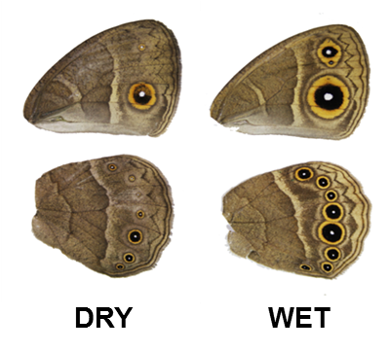
Butterflies’ wing patterns change with the seasons
Tropical butterflies adapt to their environment to improve their chances of survival. The changes are triggered by hormone signals that transmit information about temperature to the butterflies' tissues. Biologist Ana Rita Mateus shows how a complex combination of environment, physiology and genetics steers the development of young butterflies. PhD defence on 5 July.
Hot or cold
Is the weather hot or cold when the larvae of Bicyclus anyana develop into butterflies? That’s an important factor for this species. This butterfly is a native of the savannah, where there are huge differences between the wet and dry season. Butterflies that live in the wet season generally have large eye markings on their wings, while butterflies in the dry season have much smaller markings. These alternative wing patterns correspond to alternative strategies to avoid predation. There are also differences in life history and behaviour between butterflies living in different seasons. Dry season butterflies are more resistant to drought; adults display a higher investment in body reserves, have a longer lifespan and postpone reproduction.
Coping with fluctuations
Bicyclus anynana is increasingly being used as a model for studying a phenomenon called developmental plasticity, PhD candidate Ana Rita Mateus explains. This means that environmental cues influence development in such a way that organisms have completely different characteristics, although they are genetically the same. Developmental plasticity provides the means for plants and animals to cope with environmental fluctuations.
Perceiving temperature
For Bicyclus anynana, the adaptive value of the alternative seasonal phenotypes is already known, and their underlying physiological underpinnings have started to be explored. However, how animals perceive and assess temperature and how that influences development is still a black box.

Hormone
Mateus studied this topic through lab experiments. She let butterfly larvae develop at different temperatures, and was able to manipulate the different seasonal types of butterflies by injecting the hormone ecdysone at different stages of pre-adult development. Mateus discovered that not all of the butterflies’ tissues react in exactly the same way to the environmental temperature. With this study she found that different traits in the same organism have different sensitivities to the external environmental cue and to the internal hormonal signal. Her findings emphasise the complexity of the interactions between environment and physiology in shaping the development of different body parts.
Novel colours
She also studied the effect of differences in genetic predisposition on how butterflies react to temperature differences and how this affects the size of the eye markings. Butterflies with gene variants affecting eye size and colour were the most sensitive to variation in temperature. She also discovered that at low temperatures there are three groups of pigments that determine the colour of the wings, and at high temperatures four groups. Mateus also predicts that novel colours can appear on adult butterfly wings when exposed to extreme environmental conditions during development. Mateus: ‘ So far, this study underscores the complexity of genetic by environment interactions and their importance for the evolution of developmental plasticity.’
